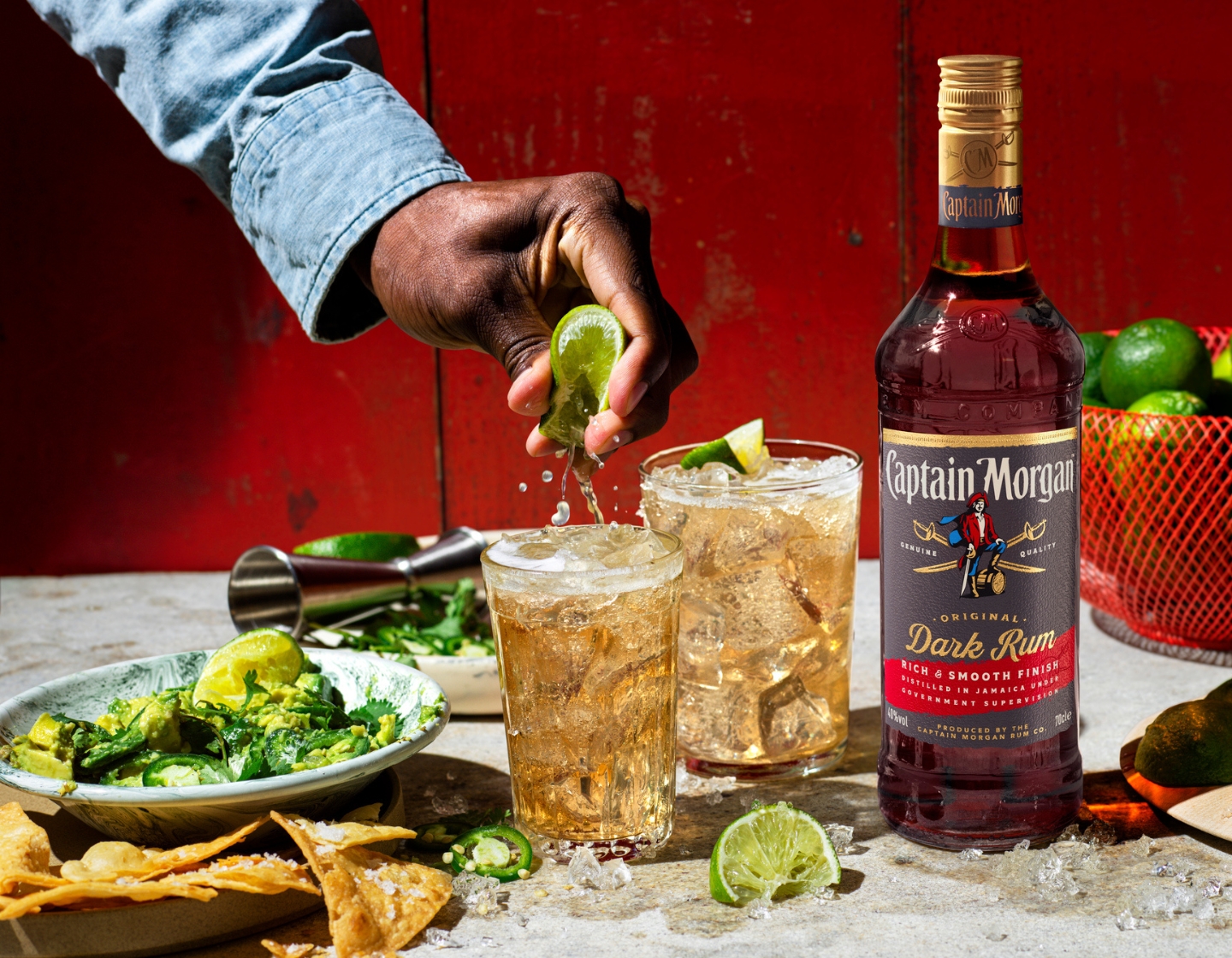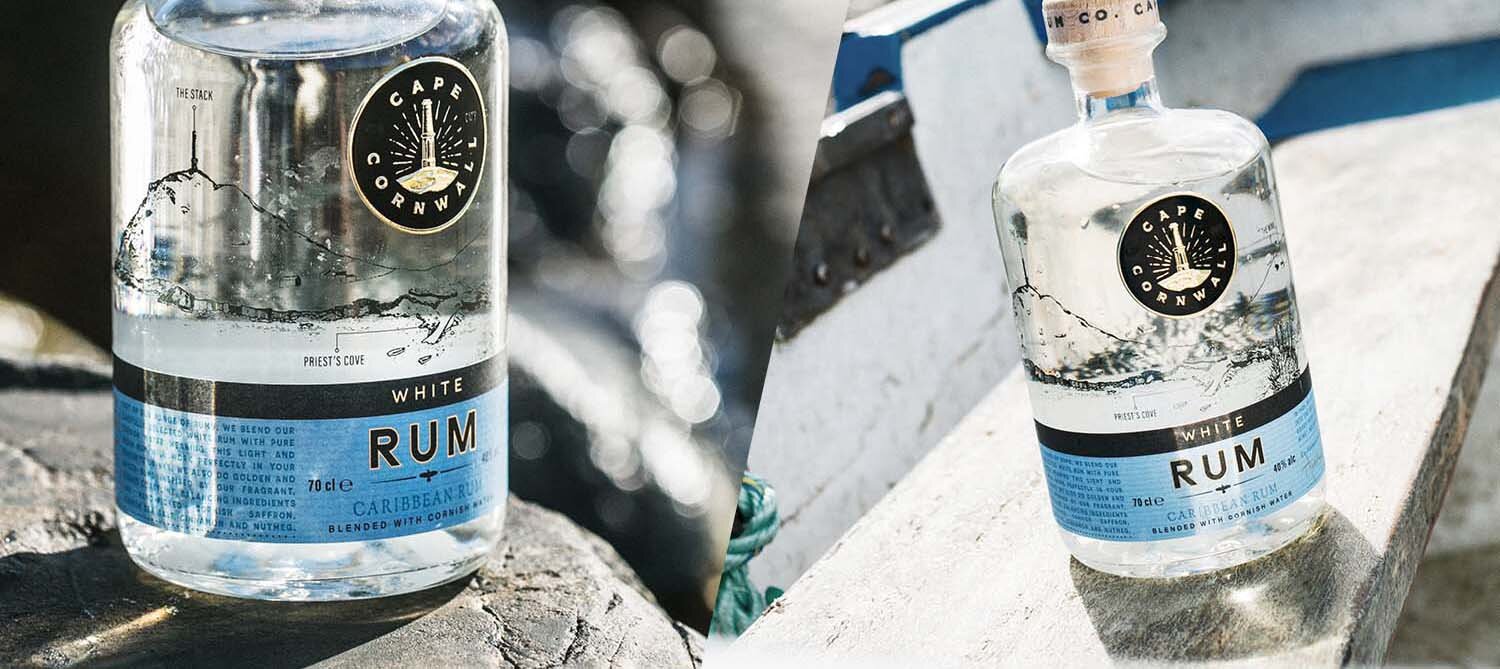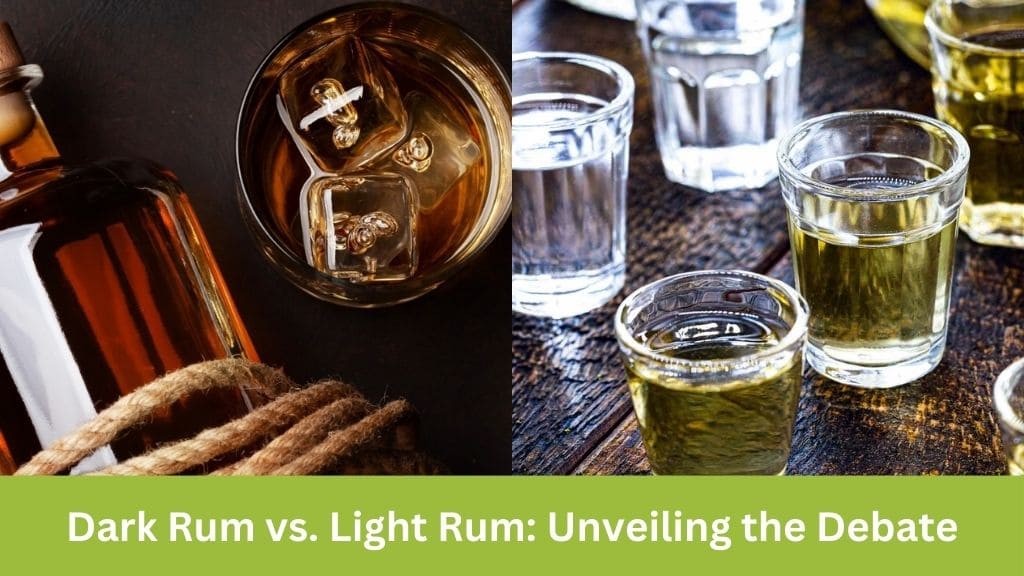Rum, a beloved spirit with roots in the Caribbean, is renowned for its versatility in cocktails and sipping. Among its variations, dark and light rum stand out as prominent contenders, each with its distinct characteristics and loyal enthusiasts. In this comprehensive exploration, we delve into the age-old question: Which is better, dark or light rum?
Rum aficionados have long debated the merits of dark and light rum, each advocating for their preferred choice based on flavor, aroma, and versatility. To unravel this discourse, we embark on a journey through the realms of distillation, aging, and mixology to discern the nuances that define these two rum varieties.
All About Dark Rum

Distillation and Aging Process
Dark rum, often hailed for its rich and complex flavor profile, undergoes a meticulous distillation and aging process. Distilled primarily in pot stills, this method imparts depth and character to the spirit. The aging process, spanning from two to seven years, takes place in oak barrels, contributing to its distinctive amber hue and nuanced taste.
Distillation Process
Dark rum is primarily distilled using pot stills, a traditional method that allows for greater retention of congeners and impurities from the raw materials, such as molasses or sugarcane juice. Pot stills operate in a batch process, where the fermented molasses or sugarcane juice is heated, vaporized, and condensed back into liquid form. This method contributes to the rich and robust flavor profile characteristic of dark rum.
Pot still distillation typically results in a lower proof spirit compared to column stills, as it retains more of the flavorful compounds present in the raw materials. The slower distillation process allows for a greater concentration of congeners, which are responsible for the complex aromas and flavors found in dark rum.
Aging Process
After distillation, dark rum undergoes an aging process in oak barrels, which imparts additional depth and complexity to the spirit. The aging process can range from two to seven years or more, depending on the desired flavor profile and quality standards of the distillery.
During aging, the rum interacts with the wood of the barrels, extracting compounds such as tannins, lignins, and vanillin, which contribute to its flavor, aroma, and color. The porous nature of oak allows for oxygen to slowly permeate the barrels, facilitating oxidation and the development of secondary flavors.
Additionally, environmental factors such as temperature fluctuations and humidity levels play a crucial role in the aging process, influencing the rate of maturation and the final characteristics of the rum.
Flavor Profile
Characterized by notes of caramel, vanilla, and spice, dark rum exudes a warmth and depth that captivates the palate. The prolonged aging process allows for the development of intricate flavors, making it a preferred choice for connoisseurs seeking a sophisticated sipping experience.
The flavor profile of dark rum is a captivating interplay of nuanced notes and complex aromas, shaped by the distillation, aging process, and raw materials used in its production. Here’s a deeper exploration of the flavors typically found in dark rum:
Richness and Depth:
Dark rum often boasts a rich and full-bodied character, characterized by deep, caramelized flavors reminiscent of molasses and brown sugar. These robust undertones lend a satisfying weight to the spirit, creating a luxurious mouthfeel that lingers on the palate.
Complexity:
One of the defining features of dark rum is its complexity, which emerges from the interaction between the spirit and the oak barrels during the aging process. Oak aging imparts a myriad of flavors, including hints of vanilla, oak, and spice, which meld seamlessly with the underlying sweetness of the rum. These intricate layers of flavor create a multi-dimensional drinking experience, with each sip revealing new nuances and subtleties.
Warmth and Spice:
Dark rum often exhibits a subtle warmth and spiciness, derived from the congeners and volatile compounds present in the spirit. Notes of cinnamon, clove, and nutmeg add depth and complexity to the flavor profile, evoking a sense of comfort and indulgence reminiscent of warm spices.
Fruit and Citrus:
While dark rum is renowned for its rich and decadent flavors, it also showcases hints of fruit and citrus that brighten and balance the palate. Undertones of ripe tropical fruits, such as banana, pineapple, and dried apricot, add a refreshing touch to the spirit, complementing its deeper, more savory notes.
Earthiness and Oak:
The aging process in oak barrels infuses dark rum with subtle earthy undertones and woody accents, contributing to its overall depth and complexity. These earthy notes, coupled with the distinct influence of oak, provide a sense of terroir and authenticity that enhances the drinking experience.
Mixology
Dark rum serves as the cornerstone of classic cocktails such as the Mai Tai, Dark and Stormy, and Rum Old Fashioned. Its bold flavor profile harmonizes with ingredients like citrus, ginger beer, and bitters, resulting in cocktails that are both robust and refined.
The mixology of dark rum encompasses a diverse array of cocktails that showcase its rich, complex flavor profile. From timeless classics to innovative creations, dark rum serves as a versatile base ingredient that adds depth and character to any concoction. Here’s a deeper dive into the mixological applications of dark rum:
Classic Cocktails:
Dark rum is a staple ingredient in many classic cocktails, each highlighting its distinctive flavor profile in unique ways:
- Mai Tai: This iconic cocktail combines dark rum with lime juice, orgeat syrup, and orange liqueur, resulting in a refreshing yet complex blend of sweet, sour, and nutty flavors.
- Dark and Stormy: A simple yet satisfying concoction of dark rum, ginger beer, and lime juice, the Dark and Stormy delivers a bold and spicy kick with a hint of citrus brightness.
- Rum Old Fashioned: A timeless twist on the classic Old Fashioned, this cocktail features dark rum muddled with sugar, bitters, and a splash of water, creating a rich and aromatic libation with a smooth, lingering finish.
Tiki Creations:
Dark rum is a cornerstone of Tiki culture, where exotic flavors and elaborate garnishes reign supreme. Tiki cocktails often feature multiple rums, tropical juices, and exotic spices, creating elaborate concoctions that transport drinkers to a tropical paradise:
- Zombie: This legendary Tiki cocktail blends dark rum with various fruit juices, grenadine, and a mix of exotic liqueurs, resulting in a potent yet balanced libation that packs a flavorful punch.
- Navy Grog: A refreshing blend of dark rum, lime juice, grapefruit juice, and honey syrup, the Navy Grog is a citrus-forward cocktail with a hint of sweetness and a touch of spice.
- Painkiller: Combining dark rum with pineapple juice, orange juice, cream of coconut, and nutmeg, the Painkiller is a creamy and indulgent concoction that evokes visions of sandy beaches and swaying palm trees.
Contemporary Creations:
Innovative mixologists continue to push the boundaries of dark rum cocktails, crafting modern libations that showcase its versatility and complexity:
- Smoked Rum Sour: This inventive twist on the classic Whiskey Sour features dark rum infused with smoky flavors, balanced with lemon juice, simple syrup, and a dash of bitters, resulting in a sophisticated and nuanced cocktail.
- Rum Manhattan: Substituting dark rum for whiskey in the traditional Manhattan recipe, this cocktail offers a rich and velvety alternative with notes of caramel, cherry, and spice, perfect for sipping on a chilly evening.
- Rum Espresso Martini: Dark rum lends a luxurious depth to the classic Espresso Martini, combining with coffee liqueur, espresso, and a touch of simple syrup for a rich and indulgent libation that balances sweetness with a bold caffeine kick.
Also read: Best Dark Rum Brands: From Appleton Estate to Zaya
Exploring Light Rum

Distillation and Aging Process
Light rum, also known as white rum, follows a contrasting path in its production. Distilled in column stills and aged for a shorter duration—typically one to two years—light rum retains a clear and colorless appearance, with a flavor profile characterized by its neutrality and versatility.
Distillation Process:
Light rum, also known as white rum, typically undergoes a straightforward distillation process that emphasizes purity and neutrality of flavor. Unlike dark rum, which is often distilled in pot stills, light rum is commonly produced using column stills.
Column stills, also known as continuous stills, allow for a more efficient and rapid distillation process. The fermented molasses or sugarcane juice is introduced at the top of the column, where it cascades down through a series of plates or trays. As it descends, the alcohol vaporizes and rises, eventually condensing into liquid form at the bottom of the column.
This method of distillation results in a lighter, cleaner spirit with a higher alcohol content compared to pot still distillation. The column still effectively separates impurities and congeners from the raw materials, producing a colorless and neutral base spirit that serves as the foundation for light rum.
Aging Process:
Unlike dark rum, which undergoes a prolonged aging process in oak barrels, light rum is typically aged for a shorter duration or not aged at all. Aging in oak barrels imparts color, flavor, and character to the spirit, which is desirable for dark rums but not for light rums.
Some light rums may undergo a brief period of aging in stainless steel tanks or inert containers to allow for slight mellowing and blending of flavors. However, the aging process is minimal compared to dark rum, with the primary goal being to maintain the spirit’s crisp and clean profile.
Flavor Profile
With subtle hints of sugarcane and a clean, crisp finish, light rum offers a blank canvas for mixologists to experiment with a myriad of flavors. Its light and airy demeanor makes it an ideal choice for cocktails that emphasize fresh ingredients and delicate flavors.
The flavor profile of light rum is characterized by its delicate and versatile nature, offering a clean and crisp palate that serves as a canvas for a wide range of flavors. Here’s a deeper exploration of the flavors typically found in light rum:
Clean and Neutral:
Light rum is renowned for its clean and neutral flavor profile, with minimal presence of congeners and impurities derived from the distillation process. This purity allows the natural sweetness of the sugarcane or molasses to shine through, creating a smooth and approachable spirit that is perfect for mixing in cocktails.
Subtle Sweetness:
While light rum lacks the deep caramelized flavors associated with dark rum, it often exhibits subtle hints of sweetness derived from the raw materials used in its production. Notes of sugarcane, vanilla, and honey impart a gentle sweetness that adds depth and complexity to the spirit without overwhelming the palate.
Crisp and Refreshing:
One of the defining characteristics of light rum is its crisp and refreshing profile, making it an ideal choice for cocktails that emphasize bright, citrusy flavors and herbal notes. The clean finish of light rum leaves the palate feeling refreshed and invigorated, making it perfect for warm-weather libations.
Versatile:
Light rum’s neutral flavor profile and gentle sweetness make it incredibly versatile in mixology, allowing it to complement a wide range of ingredients and flavor profiles. From fruity and tropical cocktails to classic and contemporary creations, light rum can adapt to any cocktail recipe with ease, adding depth and balance to the final concoction.
Fruity and Floral Undertones:
While light rum lacks the bold flavors and complexity of dark rum, it often exhibits subtle fruity and floral undertones that contribute to its overall complexity. Notes of citrus, pineapple, and coconut add a touch of brightness and vibrancy to the spirit, enhancing its appeal in a variety of cocktail applications.
Mixology
Light rum finds its place in iconic cocktails such as the Mojito, Daiquiri, and Piña Colada. Renowned for their refreshing qualities, these cocktails showcase the versatility of light rum, allowing its subtle nuances to shine amidst vibrant fruit flavors and aromatic herbs.
The mixology of light rum encompasses a diverse range of cocktails that showcase its clean and versatile flavor profile. From classic concoctions to contemporary creations, light rum serves as a versatile base spirit that enhances a wide array of cocktail recipes. Here’s a deeper exploration of the mixological applications of light rum:
Classic Cocktails:
Light rum is a staple ingredient in many beloved classic cocktails, each highlighting its crisp and refreshing flavor profile:
- Mojito: A timeless Cuban cocktail featuring light rum, fresh lime juice, mint leaves, simple syrup, and soda water. The combination of citrus, herbaceous mint, and effervescence creates a bright and invigorating libation that is perfect for warm weather sipping.
- Daiquiri: A simple yet elegant cocktail composed of light rum, fresh lime juice, and simple syrup. The balance of tart lime, subtle sweetness, and clean rum flavors makes the Daiquiri a refreshing and versatile choice for any occasion.
- Piña Colada: A tropical delight made with light rum, coconut cream, pineapple juice, and crushed ice. The creamy texture, tropical flavors, and subtle sweetness of the Piña Colada evoke visions of sandy beaches and swaying palm trees.
Tropical Concoctions:
Light rum is a key component in many tropical cocktails that celebrate the flavors of exotic fruits and spices:
- Mai Tai: A Tiki classic featuring light rum, dark rum, orange liqueur, lime juice, and orgeat syrup. The combination of citrus, almond, and rum flavors creates a complex and satisfying libation with a hint of tropical flair.
- Bahama Mama: A fruity and vibrant cocktail made with light rum, dark rum, coconut rum, pineapple juice, orange juice, grenadine, and a splash of lemon juice. The blend of tropical fruits and rum creates a luscious and indulgent drink that is perfect for sipping by the pool.
- Hurricane: A New Orleans favorite featuring light rum, dark rum, passion fruit juice, orange juice, lime juice, grenadine, and simple syrup. The bold flavors and vibrant colors of the Hurricane capture the spirit of the Big Easy, making it a popular choice for festive celebrations.
Contemporary Creations:
Innovative mixologists continue to push the boundaries of light rum cocktails, crafting modern libations that showcase its versatility and adaptability:
- Rum Punch: A customizable cocktail made with light rum, fruit juices (such as pineapple, orange, and lime), grenadine, and a splash of soda water. The combination of sweet, sour, and fruity flavors makes Rum Punch a crowd-pleasing option for parties and gatherings.
- Coconut Mojito: A tropical twist on the classic Mojito, featuring light rum, coconut water, fresh lime juice, mint leaves, and simple syrup. The addition of coconut water adds a subtle sweetness and a hint of tropical flavor to this refreshing and revitalizing cocktail.
- Rum Runner: A fruity and potent concoction made with light rum, dark rum, blackberry liqueur, banana liqueur, grenadine, orange juice, and pineapple juice. The blend of tropical fruits and rum creates a bold and flavorful drink that is perfect for sipping on a hot summer day.
The Verdict
Flavor Preference
The choice between dark and light rum ultimately boils down to personal preference. Those who favor bold, complex flavors may gravitate towards dark rum, relishing its depth and richness. Conversely, enthusiasts seeking a lighter, more versatile spirit may find solace in the crisp simplicity of light rum.
Mixological Applications
In the realm of mixology, both dark and light rum offer endless possibilities. Dark rum adds depth and character to cocktails that demand a bold flavor profile, while light rum lends itself gracefully to concoctions that prioritize freshness and balance.
Experimentation and Exploration
Rather than pitting dark against light, embracing both varieties opens the door to a world of sensory exploration. By experimenting with different cocktails and savoring the nuanced flavors of each rum type, enthusiasts can embark on a journey of discovery that transcends the confines of preference.
Conclusion
In the grand tapestry of rum culture, the debate between dark and light rum persists as a testament to the spirit’s enduring allure. Whether sipped neat, mixed into cocktails, or enjoyed as part of a tasting flight, both varieties contribute to the rich tapestry of rum appreciation. As we raise our glasses in celebration, let us toast to the diversity and complexity that make rum a timeless companion on life’s spirited adventures.
I’m Chen Mina, from Vol de Nuit, who has a special passion for bartending, especially mixing wine, beer, and cooktail. Here you will find content about alcoholic beverages, I will bring you knowledge that few people know about this drink.





